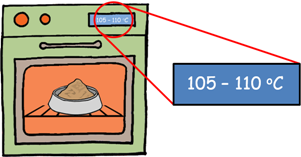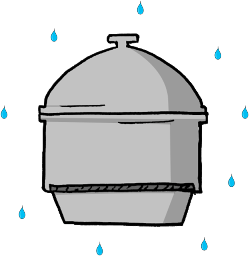 Water content, which is also called moisture content, is the quantity of water contained in a material, such as soil.
Water content, which is also called moisture content, is the quantity of water contained in a material, such as soil.
Water content is denoted by small letter w.
Water content of any soil sample is defined as the ratio of weight of water to the weight of solids present in that sample. We also multiply it by hundred because it is usually expressed as percentage.
Here weight of water is Ww and weight of solids is Ws.
Water content of soil is an important parameter which influences the behavior of soil.
Water content can be determined using several methods applied on small soil sample.
Let’s discuss one of these methods here
Oven drying method
This is a laboratory test because we need an oven for this test to perform and certainly we cannot carry an oven into the field.
It is the simplest and the most commonly adopted method for the determination of water content.
 Its procedure is very simple. Just take out a sample from soil, take its weight and put it into the oven for 24 hours then take it out and take its weight again.
Its procedure is very simple. Just take out a sample from soil, take its weight and put it into the oven for 24 hours then take it out and take its weight again.
The difference of weight will be the weight of water present in the soil sample.
A detailed procedure is that we take a clean container and weigh it accurately. Lets say this weight as W1.
Then we take some 30 to 40 gram of soil sample into the container and take its weight again and lets say it W2.

Now we place the container into the oven at a controlled temperature of one hundred and five degree to one hundred and ten degree centigrade.
We maintain this temperature because water boils and vaporizes at hundred degree centigrade and we want the water present in the sample to escape out.
Temperature higher than hundred ten degrees may break the crystalline structure of clay particles which may cause loss of chemically bound water.
But if soil is organic then lower temperature as sixty degree centigrade is recommended to avoid oxidation of organic matter present in the soil.
 If soil is sandy, that is it has large particles and large pores, then it gets completely dry in four to six hours.
If soil is sandy, that is it has large particles and large pores, then it gets completely dry in four to six hours.
And if soil is clayey, i.e. it has small particle size and small pore size, then it may take sixteen to twenty hours to fully dry.
But we maintain the laboratory practice of drying the soil sample for twenty four hours at temperature of hundred and five to hundred and ten degree centigrade.
After drying of the soil sample, we place the container, with dry soil in it, inside desiccators for it to cool down at room temperature.
 Desiccators are vessel type containers, which are used to preserve moisture sensitive items from atmospheric moisture and humidity.
Desiccators are vessel type containers, which are used to preserve moisture sensitive items from atmospheric moisture and humidity.
When container cools down to the room temperature, it is weighed again and lets say this weight is W3.
Now we have three weights
W1 = weight of container
W2 = weight of container with moist sample and
W3 = weight of container after drying the sample
From these weights we can know weight of water WW as weight of container with moist sample minus weight of container with dry sample
Ww = W2 – W3
And weight of solids WS as weight of container after drying the sample minus weight of empty container
Ws = W3 – W1
We know that by definition water content is weight of water divided by weight of solids.

So this is how we determine the water content of any soil sample using an oven.







